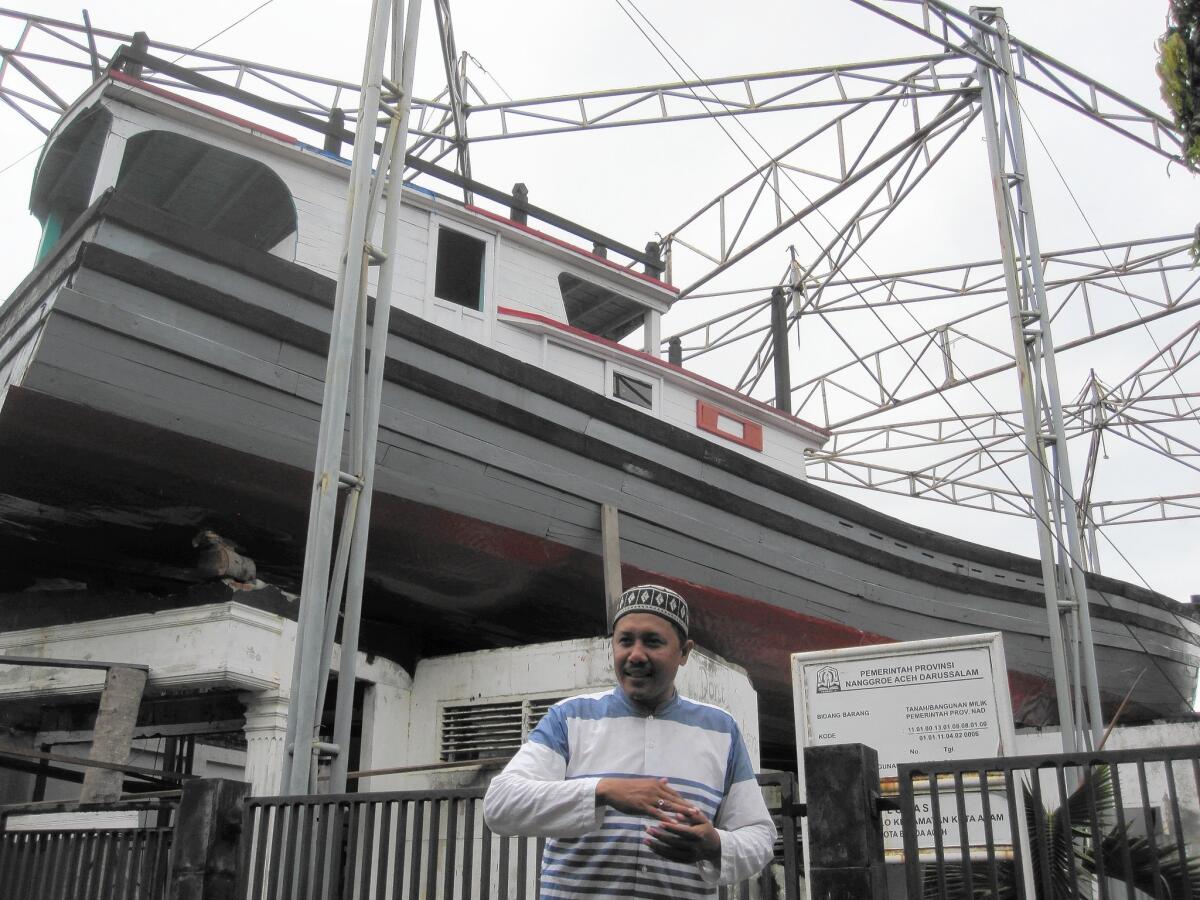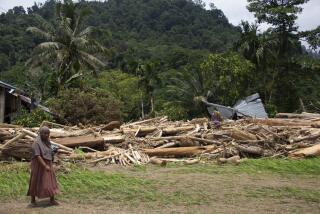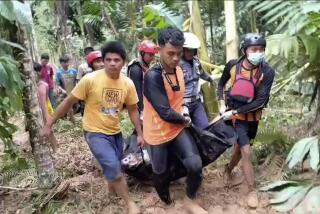Indonesia’s tsunami recovery loses momentum as aid money runs out

Where 100-foot waves flattened communities into piles of tinder wood now stand row upon row of cookie-cutter houses.
In place of still-submerged broken roadway are miles of freshly paved roads hugging the newly defined coastline and winding through mountain villages. City streets once dark, putrid and littered with bodies today bustle with cellphone stores, coffee shops, banks, hotels and even a four-story shopping mall complete with a kids’ fun zone.
“Now, we have traffic jams, never before,” says Sri Muharani, a 23-year-old law student, sitting outside a new KFC outlet in the center of town.
Thanks to billions of aid dollars and help from hundreds of international relief organizations, this city’s physical recovery from the massive earthquake and tsunami on Dec. 26, 2004, has been nothing less than spectacular.
Yet as Aceh province marks the 10th anniversary of the disaster, it is struggling to maintain momentum as its economic growth slows, unemployment increases and poverty rises. For all its successes in rebuilding after sustaining nearly $5 billion in damage, Aceh’s recovery has been highly uneven and incomplete. And now it is at risk of stalling altogether because the international relief agencies — whose largesse served as the community’s financial savior — have largely packed up and gone home.
The Indonesian government estimates that in the first few years after the tsunami, about 700 domestic and international organizations worked to deliver more than $7 billion of aid, with tens of thousands of staff on the ground. Across the tsunami zone — in which more than 230,000 people died in Indonesia, Thailand, Sri Lanka and India — about $14 billion in aid was received.
In Aceh province, which bore the brunt of the disaster with nearly 170,000 lives lost, many in coastal cities such as Banda Aceh, the influx of aid brought better living conditions, greater access to health clinics, and cleaner water and sanitation.
“Those who survived ended up with much better infrastructure and basic services,” says Tom Alcedo, the American Red Cross representative in Indonesia.
Today, however, most of the humanitarian operations in Aceh have shuttered, leaving only a few dozen minimally staffed nongovernmental organizations. Save the Children, which helped reunite about 1,300 children separated from their parents, has gone from 1,000 workers in Aceh early in the recovery to a single staffer, who focuses on microfinancing issues.
Many NGOs of course never intended to stay beyond the emergency period. Even so, when these groups left or shrank, so did the cash infusion and many jobs.
David Fazli of Aceh Besar, a neighboring area that was as hard hit as Banda Aceh, worked three years as a security guard for Oxfam. He made a solid salary of $200 a month, plus meals and transportation allowances. But that ended in 2008 when Oxfam closed its Aceh office.
Fazli, 39, had lost all seven members of his household to the tsunami, including his parents and younger sister and brother. He doesn’t know how he survived; he remembers being tossed and spun by the waves and then swept inland until he found himself washed up at a gas station nearly four miles from shore.
Now married with two children, he is scraping for whatever work he can find. Before the tsunami, Fazli labored as a construction worker on land and on an offshore rig. With the building boom over, decent-paying jobs are in short supply. Lately he goes out most afternoons to Lhoknga’s golf course looking for opportunities to caddie for a few bucks a day.
“I do anything I can,” Fazli says, wincing on a sweltering afternoon as he looks out at the empty nine-hole golf course. The weed-infested field was inundated with seawater, and, worse, washed over by sand, he says. It doesn’t help that there are wild boars in the area, and that the course is next to a mass grave for victims of the disaster, which was visited by former President Clinton in 2005.
Fazli and his family live in a home built by Catholic Relief Services, one of scores of agencies that constructed more than 140,000 permanent replacement houses in Aceh and nearby islands. Most of the homes followed a simple plan: about 400 square feet of space carved into a living room, two bedrooms, one bathroom and a kitchen.
Every household whose home was lost or damaged was entitled to a replacement dwelling. But most survivors had no proof of land ownership and the government’s land administration office in Aceh was destroyed, with 30% of its staff killed or missing. Then there were construction challenges: The sudden huge demand for wood, cement and steel caused sharp price spikes and led to smuggling of materials and other illegal dealings.
Still, most people regard the reconstruction of housing and infrastructure a success. The same cannot be said for economic development and improvement of businesses, industries and other means to provide families with a living.
Though rich in oil and gas, Aceh had seen its economic growth stunted by separatist fighting since 1976 as the Free Aceh Movement under exiled leaders battled central government forces over resources, Islamic law and other issues. Though the earthquake and tsunami brought peace, with hard-liners backing down to make room for humanitarian aid, Aceh’s rural backwaters had little in the way of any industry or livelihood to turn to, apart from farming. The relief efforts didn’t change that; there simply weren’t many livelihood-support programs in the province, said the Asian Development Bank in a detailed assessment of the recovery.
Moreover, about 80% of projects aimed at helping people become self-sufficient have been failures, concludes Saiful Mahdi, the Cornell-trained director of the International Center for Aceh and Indian Ocean Studies in Banda Aceh.
Fishing, a major industry in Aceh, provides one case study. Government reports say that within just a couple of years of the tsunami, seaports were back up and nearly all of the 4,700 lost coastal fishing boats had been replaced. But Mahdi, who returned to Aceh from the U.S. after receiving word of the devastation and the loss of 16 of his relatives, notes that some of the donated boats were too narrow. Aceh fishermen prefer wide flat-bottom boats that are more suited for shallow waters.
Similarly, big challenges remain for farming, which accounts for one-third of Aceh’s economy and about half of all employment. Mahdi says it wasn’t enough to help locals ensure that the soil is good — desalinization was a major task after the tsunami — but aid groups should have done more to help with financing, technology and sales.
“You have to follow up all the way to marketing,” he says. “It’s the whole cycle of livelihood.”
M. Kafrawi manages the operation at Forum Bangun Aceh, an Indonesian NGO that focuses on education and microfinancing. He thinks one of Aceh’s major problems is that people have become dependent on aid money. He cites community reaction to his training programs in the last couple of years.
“When we told them that we were offering skills, not money, they were not happy,” Kafrawi says. “Because there was a lot of funding from the outside, many people were expecting or asking for their share of the money.”
Moreover, most of the outside aid was directed at Aceh’s coastal cities. There was little that went into the province’s inland areas. The upshot is that much of rural Aceh has fallen further behind the more entrepreneurial and dynamic urban centers like Banda Aceh.
In the city’s fishing village of Lampulo, Mujiburrizal tells the story of how he survived the tsunami by climbing inside a 75-foot fishing vessel that was carried by the waves and landed on the roof of the house next door. After the waters receded, officials decided to leave the boat on top of the two-story house, securing it, and turned the whole thing into a sort of museum exhibit.
It’s made the 37-year-old Mujiburrizal, who, like many Indonesians, goes by a single name, a local celebrity as he has gone around giving testimonials in Indonesia and elsewhere of his Noah-like story. He also conducts tours of his neighborhood for visitors. He says he sees a future in tourism.
Abdullah Murah Raya, 69, and his wife, Nurhayati, lost two of their seven sons, along with seven employees, their seaside home and nearly all 13 of their furniture stores. It has been a slow and painful recovery, they say, but today the Raya family has three more stores than before and a new home built on the same plot of land.
“It was like starting a brand-new life,” Nurhayati says. Her husband adds: “I’m still haunted by the memories of my missing sons, the memories of losing everything. But we prayed and let it go. It was our destiny.”
More to Read
Start your day right
Sign up for Essential California for news, features and recommendations from the L.A. Times and beyond in your inbox six days a week.
You may occasionally receive promotional content from the Los Angeles Times.







